Unbeknownst to many, the Northern Lights has an equally mesmerising counterpart — the Southern Lights, or the Aurora Australis. If I were to illustrate their relationship, the Southern Lights is akin to the less glamorous sibling who is often overshadowed by her popular sister. Nevertheless, when she is thrusted into the limelight, her performance is one to remember.
The good news is, you can witness Mother Nature’s masterpiece without having to make the pilgrimage to far-flung places such as Norway or Iceland. Journey south instead to our picks of the best places in the world to catch the Southern Lights!
1. Cradle Mountain-Lake St Clair National Park, Tasmania
When there’s whispers of a possible aurora, expect to find yourself surrounded by avid wanderlusters converging in Cradle Mountain-Lake St Clair National Park. Here, they gather in hopes of glimpsing this coveted sight. It’s no surprise really, as the park’s flat, mirrored lakes with nary a high-rise building in sight provide an unobstructed view of this fairytale-like spectacle.
Fun fact: Its myrtle forests are a whopping 60 million years old. It’s truly living history, if you will.
Come March to September, head to the still waters of its iconic Dove Lake, which is glacially carved beneath Cradle Mountain. This guarantees front row seats to nature’s light spectacle in unadulterated nature, should it be on display. Its calm waters reflect the aurora-streaked skies, so it’s an even more spectacular sight.
Part of the Tasmanian Wilderness World Heritage Area (TWWHA), this is regarded as one of Australia’s most beautiful parks. Not only is this the prime location to catch greenish-pink lights wheeling in the skies; it is also home to a gorgeous display of wildflowers such as orchids and leatherwoods. Moreover, adventurous souls can rise to the challenge of tackling the epic Overland Track, Australia’s scenic alpine walk.
Fun fact: TWWHA is one of Australia’s largest conservation areas, covering almost 20% of Tasmania.
That said, there remains plenty to do, even if you are thwarted by nature’s fickle light show. Can’t get enough of its vast wilderness? Why not stay for a night or two at the park’s nature retreats — Peppers Cradle Mountain Lodge or Pumphouse Point? This just might increase your chances of catching the Southern Lights, too.
2. Bridestowe Lavender Estate, Tasmania
No trip to the Land Down Under is complete without swinging by Bridestowe Lavender Estate. You are bound to be enthralled by its soothing lavender blooms, which stretch on for miles and miles. The moment you step into this floral paradise, the sea of purple never seems to end.
But the best is yet to come, as when night falls, this farm transforms into a hotspot for aurora sightings. Where else can you glimpse the sky morphing into a myriad of hues above a dreamy blanket of 650,000 flourishing lavenders? It’s not difficult to see why this is an astrophotographer’s paradise.
3. South Arm Peninsula, Tasmania
Just 40km south-east of Hobart lies the South Arm Peninsula, a U-shaped narrow neck of land home to pristine beaches. You’ll find that its wide and still bays provide a sweeping view of hues emanating all around the horizon. This makes it one of the best vantage points to behold the Southern Lights.
Avid aurora hunters, be sure to head down from March to September during aurora peak season. Clifton and Calverts’ Beaches promise a heart-pounding experience of chasing this natural phenomena. Both face south, which is crucial when it comes to aurora-hunting. The waves of luminescent lights painted in a colour palette of purplish-green are bound to feed your wanderlust, if lady luck is on your side.
4. Lake Ellesmere, New Zealand
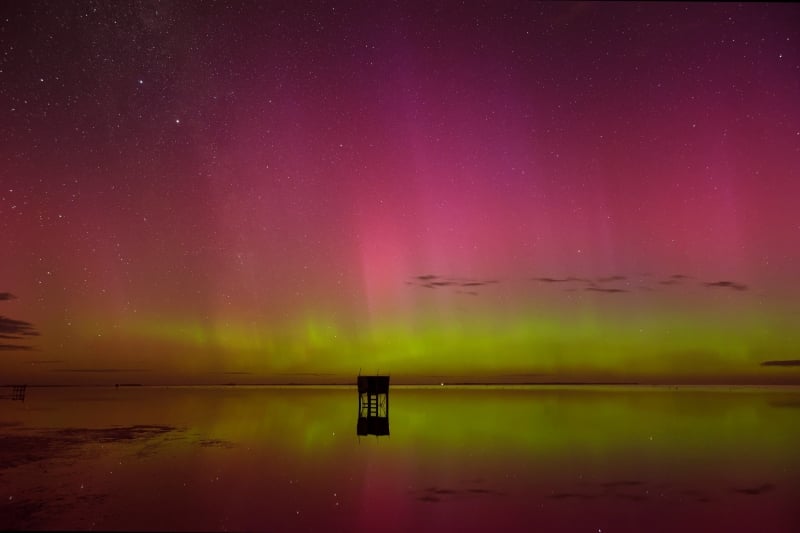
Seeing the pinkish-green wisps hanging on the horizon is bound to be a surreal moment. | Image credit: Ben
Canterbury’s largest and New Zealand’s fifth largest lake, Lake Ellesmere is a hotspot for birdwatching. Glimpse rarities such as Red-necked Stint and Pacific Golden Plover, as well as common yet striking fowl such as Black Swans. Moreover, many adrenaline junkies travel to the area to partake in a variety of recreational water sports, from sailing to jet skiing. However, the highlight is definitely watching this aurora viewing paradise come alive from March to September.
After an adrenaline-filled day, what could be more comforting than watching a celestial ballet of light dance in the scintillating night skies?
5. Little River, New Zealand
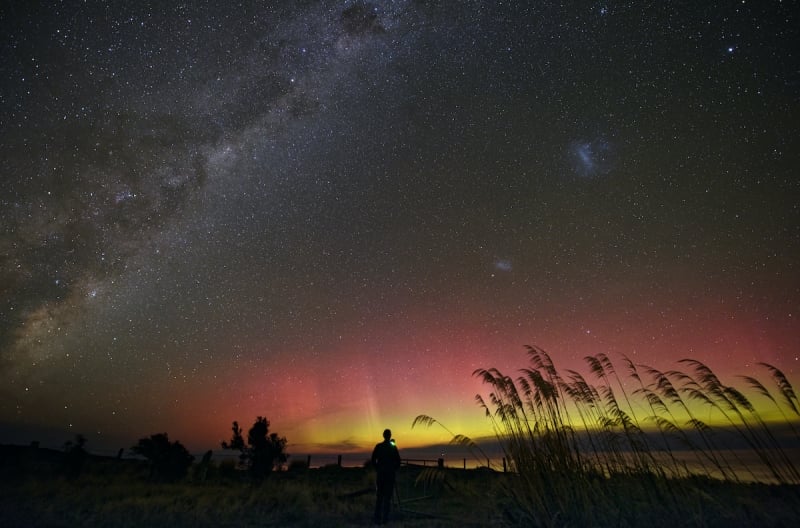
This is the perfect spot to contemplate nature’s wonders. | Image credit: Ben
If you are craving to experience the enchantment of pinkish-yellow fires glowing from the heavens above, heading to Little River would be your best bet. Leave the hustle and bustle of Christchurch behind by heading to Little River, which is a quaint little town sitting along the road from Christchurch to Akaroa. Much of its charm comes from its artists selling arts and crafts, or its vintage railway wagons. We recommend making a pit-stop here and enjoying a steaming cup of coffee while taking in the breathtaking beauty of Banks Peninsula.
What’s more, night brings along with it an exceptional visitor. Feast your eyes on the hypnotising astronomical swirls of colours which await you in this hidden gem.
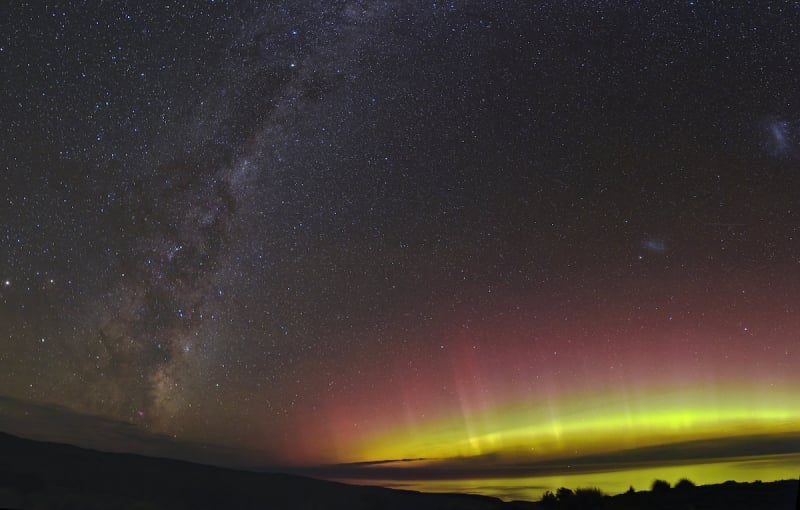
Image credit: Ben
Besides the Southern Lights, you might even chance upon its companion; the Milky Way. We could go on and on, but we will let the pictures speak for themselves. The gradients of colours are astounding, to say the least.
6. The Catlins, New Zealand
This picturesque coastal stretch boasts of cascading waterfalls, lush greenery fringed by jagged cliffs, and rich wildlife. But keen aurora chasers will know that this is a beloved spot for viewing the clear night skies.
Marvel at the outgoing tide at Curio Bay, which reveals a 180 million-year-old Jurassic fossil forest. Otherwise, travel to Waipapa Light House to spot sea lions sunbathing in the day. From March to September, dusk transfigures this widely photographed lighthouse into an aurora wonderland, with a clear view south. Savour the ethereal beauty of lulling waves breaking into shades of greenish-purple, and ready your cameras to snap picture-perfect memories.
Tip: While you’re at it, why not take a time lapse, too? A time lapse can preserve the ever-changing colours of this technicolour light show.
Even if the night does not favour the appearance of this fleeting wonder, New Zealand is home to one of the least polluted night skies in the world. This allows hopeful sky-watchers a consolation prize, at the very least.
7. Dunedin, New Zealand
Mark your calendars, as the aurora season in Dunedin falls between March to September. Hoopers Inlet in particular attracts the adulation of many. The glorious spectrum of pink and yellowish-green ribbons in the sky bathes the landscape in a soft pastel colour.
Tip: Alternatively, if you are visiting on a Sunday, the local astronomical society opens the Beverly-Begg Observatory to the public after 6pm.
Of course, catching this symphony of colour is not guaranteed. So if you do chance upon this captivating sight, don’t take it for granted! Consider the heavens’ way of smiling down upon you and your journey. Nevertheless, its elusiveness makes it all the more appreciated. So when you visit, keep your fingers crossed; the anticipation makes it even more of an adventure.
8. Stewart Island, New Zealand
Roughly 85% of Stewart Island forms the Rakiura National Park. Not only is this tropical paradise home to sun-kissed beaches and a turquoise sea, it is also a trekking haven. True-blue hikers are welcomed to take their pick from its walking tracks, which stretch over 280km. Be bedazzled by its sunrises, and its sunset skies bursting into a kaleidoscope of colours.
Blessed with regular sightings of the Southern Lights, this speaks volumes about its moniker Rakiura, which translates to “land of the glowing skies” in New Zealand’s indigenous language Maori. This is indisputably one of the world’s best places which promises an intimate experience with the Southern Lights. Take our word for it, or let its international acclamation as a Dark Sky Sanctuary speak for itself.
Fun fact: The Dark Sky Sanctuary status is awarded to places that possess an exceptional quality of starry nights.
The best time to visit is from March to September, as less daylight during its winter months translates into higher chances of aurora sightings.
Fun fact: The aurora hangs relatively low on the horizon in the southern sky. This allows you to play around with your photographs, framing it over mountains, or capturing it as reflections in lakes.
9. Aoraki Mackenzie International Dark Sky Reserve, New Zealand
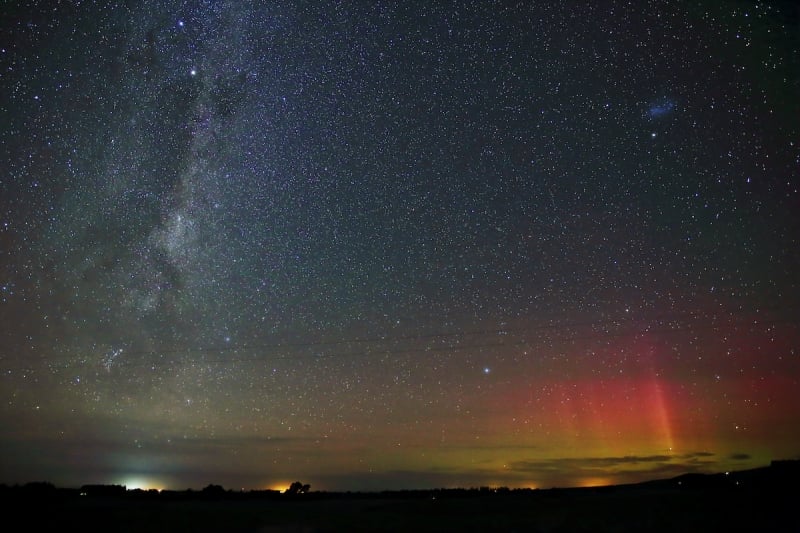
The tranquility at the South Island is almost unrivalled. | Image credit: Paul Stewart
Nestled in the heart of the Mackenzie Basin in the South Island of New Zealand, Aoraki Mackenzie International Dark Sky Reserve is Aotearoa’s best-kept secret. This is the sweet spot for studying stunning constellations.
Perhaps the allure of catching the Southern Lights here lies in its crystal clear skies, unique to the Mackenzie Region. If you are lucky and weather permits, you might even be able to see the Southern Cross, Magellanic Clouds, and the Milky Way, which are exclusive to the southern hemisphere. This is thanks to minimal light pollution in the area.
Also read: 8 Fantastic Reasons Why We Love New Zealand (And Why We Think You Will, Too)
Looking back, I don’t know what must have been running through my mind the last time I thought of making New Zealand a stopover — when it clearly should have been a destination.
10. Antarctica
If you have ticked all the above off your travel wishlist, why not venture further to Antarctica for an adventure of a lifetime? Not everyone might be able to bear the rugged and challenging expedition to this freezing cold land, but we promise this is well worth the chase. Besides, what’s life without its thrills? Taking in the otherworldly sight of electrifying streaks of green against the backdrop of a snowy wilderness is purely magical. We don’t know about you, but the mere thought sends us quivering with anticipation.
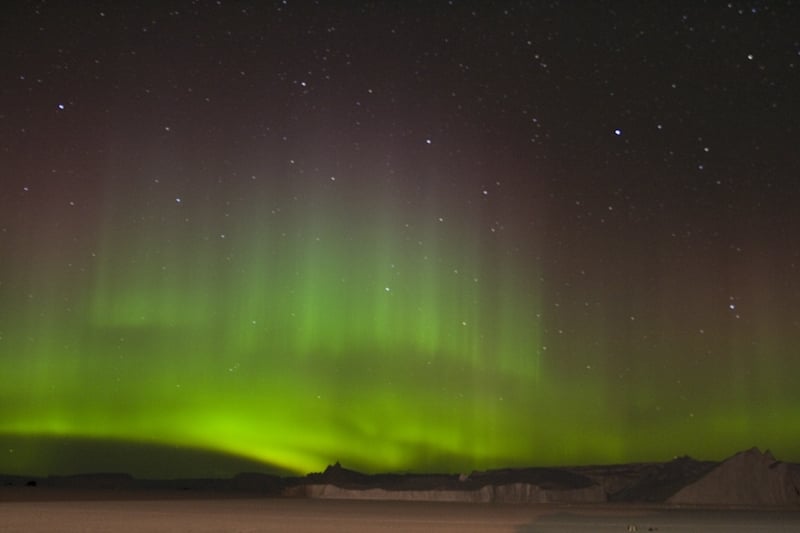
Brave the cold and you just might witness nature’s true colours. | Image credit: Samuel Blanc
While the Antarctic winter is not hospitable to any traveller, there remains opportunities to witness the Southern Lights well into March. Furthermore, year-round sightings have been reported.
Why it’s worth catching the Southern Lights over the Northern Lights
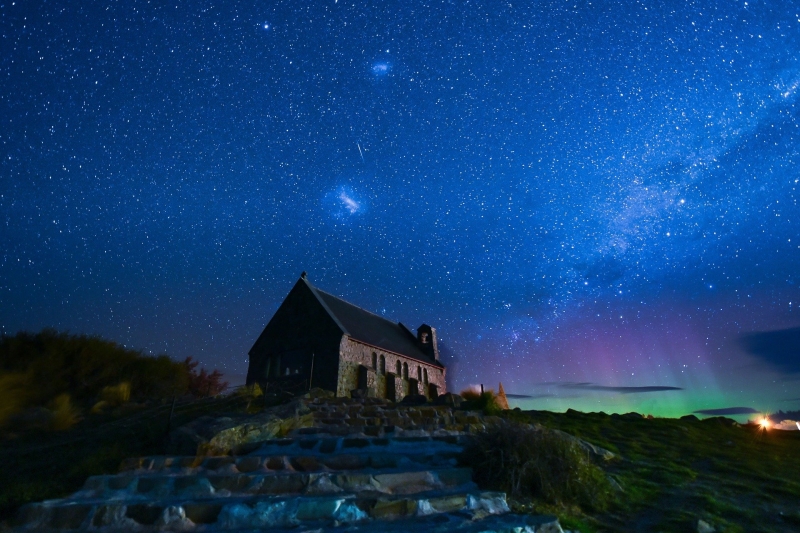
The Southern Lights are just as, if not even more spellbinding than its northern sibling. It goes beyond the Northern Lights’ usual blues and greens, to include vibrant colours such as pinks, oranges, purples, and even golds.
Furthermore, the Southern Lights is mostly best viewed from March to September, which coincides with the off-peak travelling season. Therefore, you can avoid the throngs of tourists that usually flock to these destinations on their summer travels.
In addition, there have been reports of the Northern Lights dimming, and being more unpredictable over the next decade. Hence, why not maximise your aurora-sighting chances by travelling south instead? No one likes to be sorely disappointed after pining endlessly!
Some wait years, or even a lifetime to glimpse this spiritually inspiring natural wonder. I believe that everyone should see this riveting sight at least once. Once would be so much more than enough.
The post 10 Best Places to Catch The Southern Lights appeared first on TinySG.
from TinySG https://tinysg.com/10-best-places-to-catch-the-southern-lights/?utm_source=rss&utm_medium=rss&utm_campaign=10-best-places-to-catch-the-southern-lights

No comments:
Post a Comment